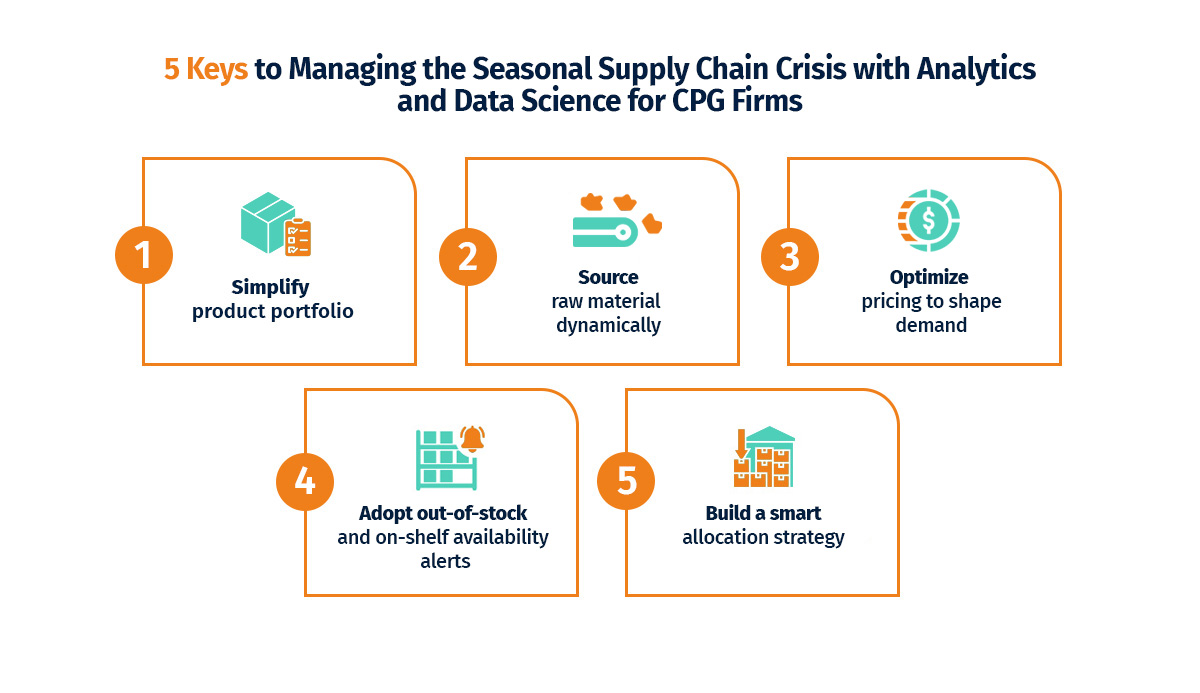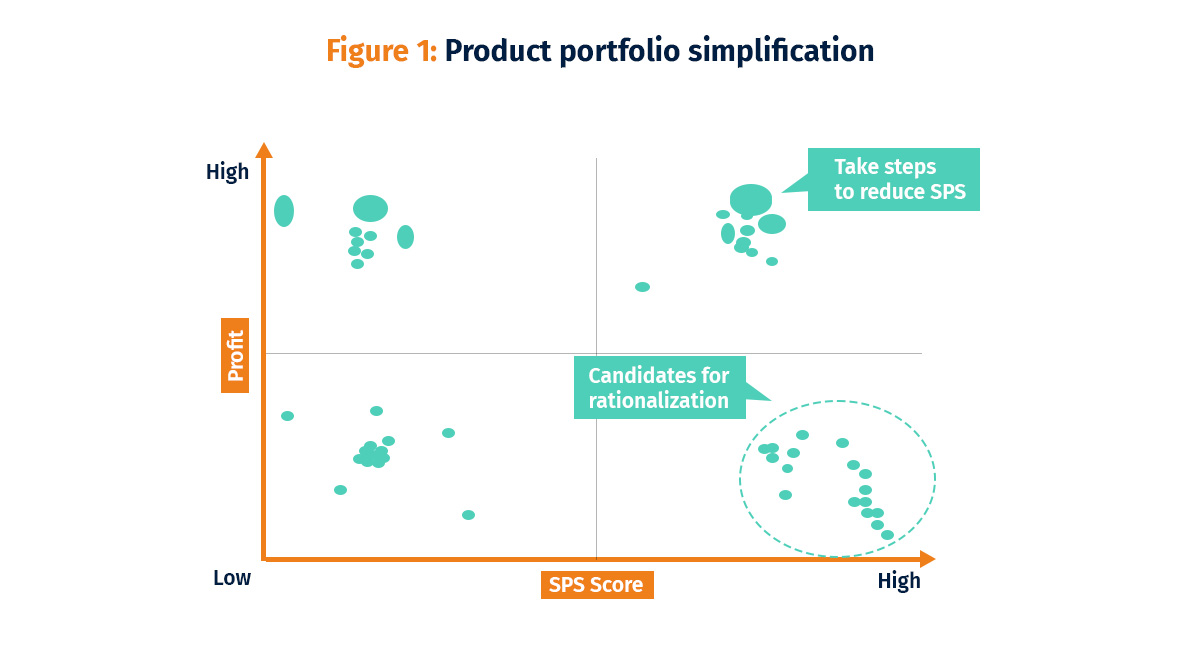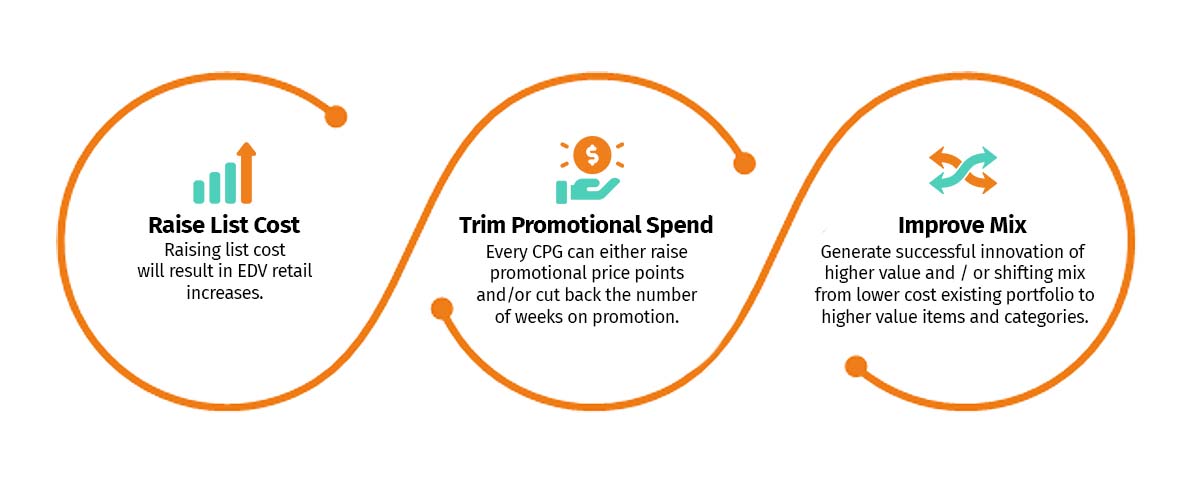
Shoppers across the globe will likely be greeted by empty shelves or website stock-outs during the 2021 holiday season. It’s a perfect supply chain storm of increased demand and severely constrained supply and labor. Pent-up demand from the pandemic is leading to an increase in both online and in-store orders while, Covid-19-related restrictions, combined with container shortages, labor and driver shortages, port congestion and railroad bottlenecks, have constricted supply like never before.
A CPG supply chain is incredibly difficult to manage. The distribution networks in the CPG value chain involve multiple production layers and often operate worldwide. Companies have to handle evolving consumer requirements, logistical problems, and unexpected disruptions; however, they could overcome these barriers by employing the correct strategies and tools, such as supply chain solutions and data analytics services. They may avoid potential errors, simplify their processes, and ensure their products reach consumers when and where they need them by strategically leveraging data-driven insights.
With a modern CPG supply chain analytics solution, enterprises can navigate seasonal delays/disruptions while developing resiliency for future challenges, ensuring they stay ahead in the fierce marketplace.
Inventories are near a 30-year low and toymakers are urging consumers to shop months early for holiday gifts. Shipping costs have increased by over 300% compared to January 2020. An unprecedented number of ships are waiting to dock at Southern California ports. By the end of September, 73 container ships were anchored off California, waiting for a berth. U.S. President Joseph Biden announced on Oct. 9 that the Los Angeles port will operate 24×7 to clear the backlog, but even that is not going to be enough. There is no end in sight for any of these problems.
- More than 20% of CPG supply chain executives are planning to reduce the number of SKUs in their product portfolio but are not sure of the overall rationalization strategy.
- More than 45% of CPG supply chain executives want to multi-source materials and expand their supplier base but lack an expansion plan.
- More than 40% of CPG supply chain executives aim to maintain a higher level of inventory for critical SKUs and reduce stock-out scenarios but have no visibility.
The importance of an equitable approach to managing SKUs and maintaining optimal inventory levels has been emphasized by the current "out-of-stock supply chain crisis." Overly rigid supply chains are susceptible to an "out of stock" situation, which bothers customers and reduces sales. On the contrary, maintaining a great deal of inventory can result in higher storage costs and waste if commodities depreciate or become obsolete before they are sold. Finding what is known as the "sweet spot" to ensure there is enough stock to meet demand without crowding warehouses or adding extra costs is thus difficult. Companies could achieve this delicate balance with advanced CPG data analytics and supply chain data science solutions, improving their capacity to handle unforeseen demand or supply disruptions fluctuations.
But, how can CPG firms deal with these unavoidable supply chain issues in the short term?
A consumer packaged goods supply chain manages product flow and tackles seasonal disruptions using SKU rationalization, dynamic sourcing, and AI-driven inventory. Real-time alerts, pricing optimization, and analytics boost agility, reduce costs, and prevent stockouts in volatile markets.
Following are 5 steps CPG analytics companies can take in the immediate short term to deal with these ongoing challenges.
What is CPG Supply chain
CPG supply chains manage global product flow through SKU rationalization, dynamic sourcing & AI-driven inventory. Key strategies include real-time stock alerts, pricing optimization & smart allocation to prevent stockouts. It can help reduce costs while improving shelf availability in volatile markets.

1. Simplify product portfolio
CPG companies can decrease complexity within the supply chain analytics by reducing product variations or discontinuing less profitable or high complexity SKUs. This involves 3 simple steps:
- SKU Classification: Classify SKUs by Stockout Possibility Score (SPS). SPS is calculated at an SKU/store (or warehouse) level and depends on:
- SKU Segmentation: Segment SKUs based on profit versus the Stockout Possibility Score. Calculate profit considering increased transportation and labor costs.
- SKU Rationalization: Discontinue SKUs in the high SPS and low-profit segments. Keep an eye on the SKUs with high profit and high SPS scores, then take immediate steps to reduce the SPS score of these SKUs.

Reducing complexity can increase certainty—and sales.
2. Source raw material dynamically
Build a dynamic sourcing plan that optimizes orders over the network in each planning cycle after observing demand signals and supplier’s performance scorecard. This approach, supported by a supply chain control tower, inventory optimization, and supply chain digital transformation, enables firms to minimize costs, reduce risk, and ensure timely shipping of orders, instead of solely adjusting the proportion of shipments from each supplier.
Want to embark on an AI-driven transformation to solve your CPG supply chain challenges? Know how organizations with AI-driven supply chains are resolving the current global crisis.
3. Optimize pricing to shape demand
During times of supply chain disruption, channels can adjust pricing to curb demand while maintaining/gaining revenue. There are three options for making an impact by optimizing pricing:

When there are supply constraints, a CPG may utilize one or a combination of the three to impact the market. In the case of long-term supply disruption, raising list costs is a must. With EDV pricing, you must factor in channel coherency, price gaps compared to the key competition, brand role within the category, retailer price guidelines and their impact on consumer demand. In addition, CPGs should look for ways to shift consumer demand from the most impacted products to the least impacted products within their category portfolio. For short-term CPG supply chain challenges, the quickest action is to adjust upcoming promotional plans to curb high-volume demand. There is a risk that households will switch their spending to competitive brands; however, this risk is reduced during supply-chain issues since it is typically an industry-wide problem.
supplier.
Your ability to apply what you've picked up from focused supply chain modernization efforts will grow as you better understand the history and factors that led to the current supply chain issues. Learn about the history of supply chain disruptions here.
4. Adopt out-of-stock and on-shelf availability alerts
An automated alert system can pre-empt out of stocks based on real inventory levels (after accounting for phantom inventory) and expected sell-out trends in the upcoming days and weeks, ensuring on-shelf availability. Based on these alerts, organizations should increase POs well in advance so stock is replenished before inventory runs out. Machine learning can raise alerts for misplaced, damaged, and/or phantom inventory within stores and include a mechanism to directly alert the store task force.
5. Build a smart allocation strategy
Finally, savvy organizations should leverage supply chain data analytics and distribute inventory in distribution centers and fulfillment centers based on trends, which can be gauged through an accurate and precise demand-sensing exercise done at the SKU level. Allocate higher inventory in the hot spots or high-demand clusters and maintain healthy stock levels elsewhere.
Accelerator-based Machine Learning Solutions can help CPG companies take these steps and more, saving time, money and energy. Machine learning algorithms working together with employees can help companies across the globe navigate ongoing supply chain challenges while delighting their customers, treating their employees well and delivering on their promises.
Our industry-leading supply chain analytics strategy can successfully address the issues facing the CPG supply chain of today by improving visibility, reducing costs, and managing supply risks. Looking for expert supply chain consulting in orchestrating end-to-end visibility and autonomous planning? Tredence’s intelligent supply chain control tower solution can be your answer. To discover more, contact the Tredence experts right away.
Topic Tags
Next Topic
Everything that’s wrong with your customer analytics program and how to fix it
Next Topic







